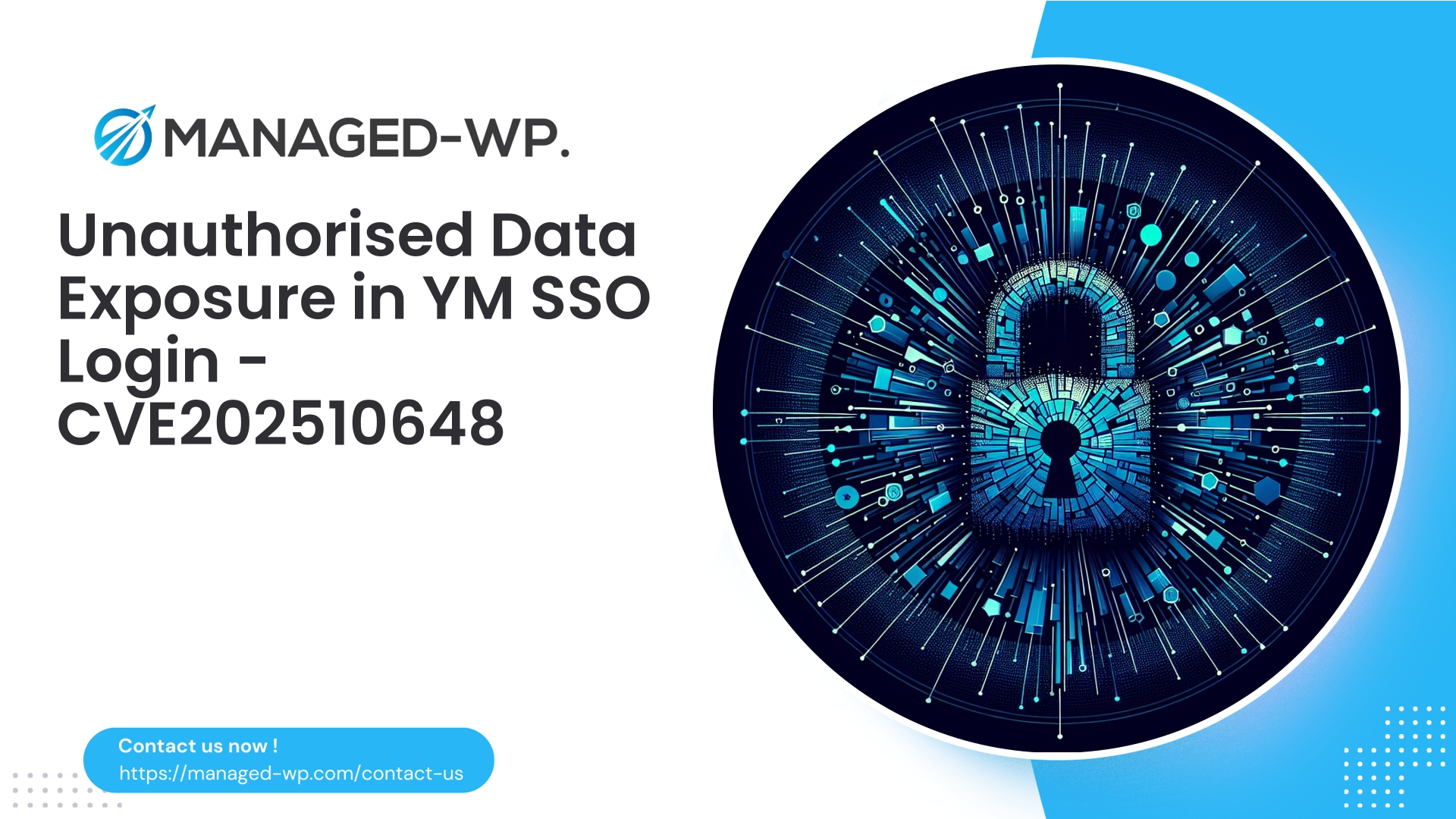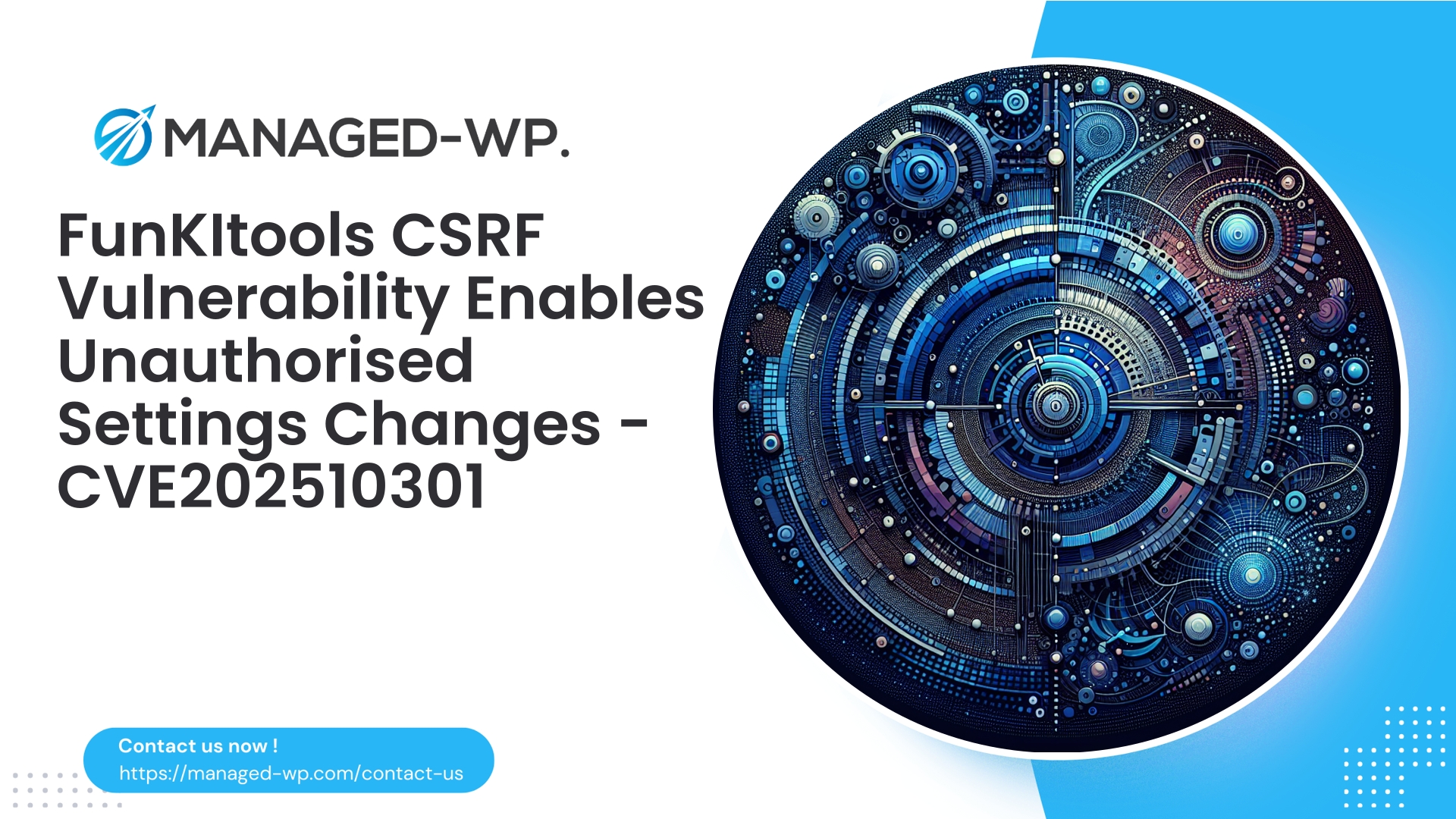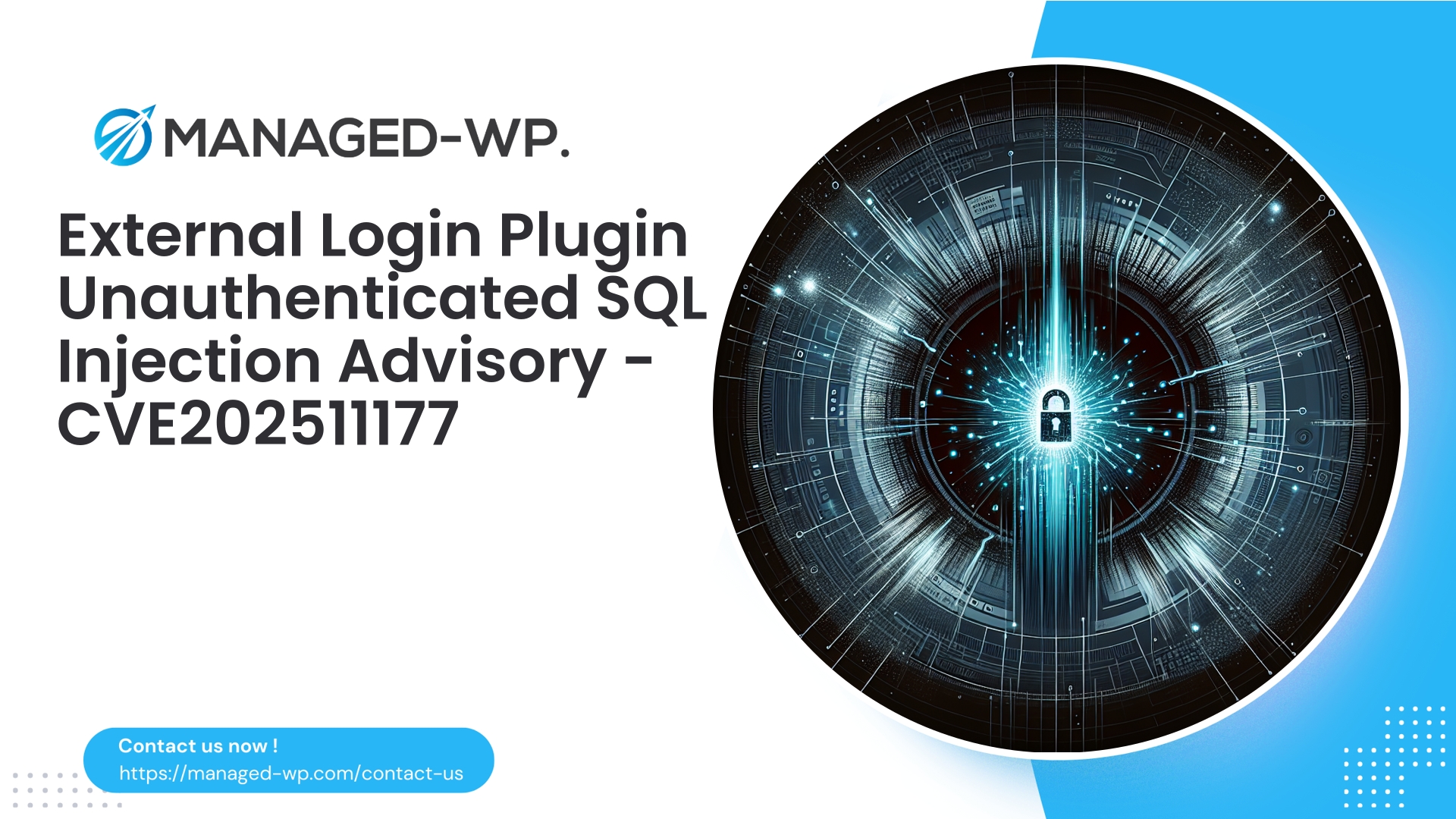| 插件名稱 | 您的會員資格單點登入 |
|---|---|
| 漏洞類型 | 未經身份驗證的訪問 |
| CVE編號 | CVE-2025-10648 |
| 緊急 | 低的 |
| CVE 發布日期 | 2025-10-15 |
| 來源網址 | CVE-2025-10648 |
緊急安全公告:YourMembership 單一登入外掛程式(<= 1.1.7)-未經驗證的存取洩漏(CVE-2025-10648)
發布日期: 2025年10月15日
作者: 託管 WordPress 安全團隊
本安全公告由總部位於美國的領先 WordPress 安全專家 Managed-WP 發布。我們的目的是清楚闡述此漏洞相關的風險,展示潛在的攻擊者行為,並為 WordPress 管理員和安全專業人員提供可立即實施的緩解策略。
執行摘要
已識別的存取控制漏洞 CVE-2025-10648 此漏洞影響 WordPress 外掛程式「Login with YourMembership – YM SSO Login」的 1.1.7 及更早版本。該漏洞源自於原本供內部使用的函數被揭露,該函數在未驗證授權憑證的情況下洩漏了敏感的測試屬性。這項疏忽使得任何未經身份驗證的使用者都能查詢和檢索本應保密的受限資訊。
雖然此問題的 CVSS 評級為中等 (5.3),但其運行環境凸顯了其重要性——因為洩漏的資料可能包含關鍵識別碼、配置詳情和偵錯資訊。此類情報可被利用來發動後續攻擊,例如撞庫攻擊、定向網路釣魚和權限提升。截至本文發布之日,插件開發者尚未發布官方補丁。
如果您的基礎架構包含此插件,請優先立即評估並實施緩解措施。建議的保護措施包括停用該插件、透過 Web 應用程式防火牆 (WAF) 設定存取限制,或在官方修復之前隔離易受攻擊的端點。
了解漏洞
- 類型: 存取控制失效/缺少授權(OWASP A05)
- 受影響的功能:
moym_display_test_attributes外掛內的方法 - 受影響版本: YM SSO 登入插件,版本最高至 1.1.7。
- 需要存取權限: 無(未經認證)
- 參考: CVE-2025-10648
此漏洞的出現是因為該外掛程式在未執行任何身份驗證或授權檢查的情況下暴露了一個內部診斷函數。攻擊者可以遠端呼叫此函數並取得本應受到嚴格保護的內部「測試屬性」。
根據此類洩漏事件的典型情況,洩漏的資訊可能包括但不限於:
- 調試標誌和內部標記
- 使用者/成員標識符
- 配置參數和內部 API 端點
- 部分單一登入 (SSO) 映射
- 可能洩漏伺服器環境詳情的錯誤輸出
即使看似微不足道的洩漏數據,也能透過提供偵察資訊和促進定向攻擊,大幅降低攻擊者的努力。
為什麼這至關重要:實際影響
- 偵察賦能器: 攻擊者可以深入了解您的 SSO 設置,包括識別碼和配置數據,這有助於製定更精確、更有效的攻擊,例如憑證填充和社會工程攻擊。
- 潛在的資格認證風險: 雖然不能確定是否存在完整的憑證,但偵錯輸出有時會包含部分令牌或 API 金鑰,這些都可能被攻擊者利用。
- 權限提升風險: 了解 SSO 映射可以讓攻擊者設計冒充或提升權限的方案,從而擴大威脅範圍。
- 漏洞鏈: 當與其他弱點結合時,該缺陷可能成為進一步利用的入口。
- 自動化大規模剝削: 缺乏身份驗證會導致自動化掃描和攻擊活動廣泛發生。
鑑於這些因素,儘管漏洞的緊急程度被標記為“低”,但也必須迅速修復。
潛在攻擊者方法
雖然我們不提供漏洞程式碼,但概念上的漏洞利用流程可能包括:
- 透過自動漏洞掃描器或探測常見的 WordPress AJAX 和插件特定的 REST 端點來定位存在漏洞的插件端點。
- 呼叫
moym_display_test_attributes未提供身份驗證憑證的操作。 - 收集返回資料以識別 API 端點、偵錯標誌或使用者識別碼。
- 利用收集到的情報進行進階攻擊,例如定向網路釣魚、令牌生成嘗試或與其他漏洞連結攻擊。
未經身份驗證的存取使得該漏洞對大規模掃描和利用極具吸引力。
如何判斷您的網站是否受到影響
- 插件清單: 掃描所有 WordPress 環境,尋找是否存在「Login with YourMembership – YM SSO Login」外掛程式版本 1.1.7 或更早版本。
- 日誌審查: 檢查訪問日誌和應用程式日誌,查找可疑的請求:
admin-ajax.php?action=moym_display_test_attributes- 包含 URL 的
使用您的會員身分登入/插件路徑 - 傳回未經授權的內部資料的請求,其中包含諸如“test”或“moym”之類的關鍵字
- 安全掃描: 使用可信任的 WordPress 漏洞掃描器或安全服務來偵測存在漏洞的外掛程式版本和缺少的授權。
- 代碼檢查(如具備資格): 檢視插件原始碼
moym_display_test_attributes功能,驗證是否進行了正確的使用者能力檢查(current_user_can('manage_options'))或使用隨機數。缺乏此類檢查證實了漏洞的存在。
重要的: 為避免未經授權的掃描,請將測試範圍限制在您擁有或獲得明確許可的系統上。
您可以立即採取的緩解措施
- 停用或移除外掛程式: 如果該功能並非至關重要,請停用並解除安裝 YM SSO 登入外掛程式以消除風險。
- WAF 或伺服器級存取限制: 阻止針對易受攻擊操作的請求,例如:
- 拒絕請求
admin-ajax.php和action=moym_display_test_attributes - 透過 Web 伺服器規則限制對插件 PHP 檔案的訪問
- 拒絕請求
- 在伺服器層級強制執行身份驗證: 使用 .htaccess 或 nginx-authentication 規則保護外掛端點,以防止未經驗證的存取。
- 基於IP的存取控制: 盡可能限制對插件端點的訪問,僅允許受信任的 IP 位址存取。
- 臨時代碼更改: 重新命名或註解掉存在漏洞的函數,並進行仔細測試和備份(僅建議具有開發專業知識的管理員執行此操作)。
- 禁用調試和錯誤輸出: 確保
WP_DEBUG生產環境中關閉了錯誤顯示功能,以減少資訊外洩。 - 監控日誌並設定警報: 增加日誌記錄,並針對意外存取模式建立警報,特別是涉及外掛程式端點的未經驗證的 200 HTTP 回應。
虛擬補丁/WAF規則範例(概念性)
以下是一些 Web 應用防火牆的防禦控制範例。請根據您的平台語法(ModSecurity、nginx、Cloud WAF 等)進行調整:
- 阻止對
admin-ajax.php其中查詢參數等於action=moym_display_test_attributes請求未經身份驗證。 - 拒絕存取包含以下內容的插件檔案路徑
/wp-content/plugins/login-with-yourmembership/如果可疑參數莫伊姆或者顯示測試屬性存在。 - 對針對已知易受攻擊的插件端點的未經身份驗證的請求進行速率限製或提供 CAPTCHA 挑戰。
- 限制此插件公開的 REST API 端點,要求進行身份驗證,或完全阻止訪問,直到修復為止。
範例概念: 如果路徑包含 admin-ajax.php查詢包括 action=moym_display_test_attributes如果使用者未經身份驗證,則傳回 HTTP 403 Forbidden 或 CAPTCHA 挑戰。
長期補救措施和最佳實踐
- 外掛程式管理: 在生產環境部署之前,使用測試環境移除未使用的插件並保持關鍵插件的更新。
- 單一登入安全加固: 將 SSO 連接器視為敏感基礎設施,需要採用最小權限原則和仔細的權限映射。
- 停用生產環境中的測試端點: 請確保在生產環境中停用所有測試/調試功能。
- 縱深防禦: 多層防護措施包括 WAF、主機/網路存取控制、雙重認證以及管理區域的 IP 白名單。
- 事件準備: 維護有記錄的事件回應計劃,執行定期備份,並確保復原流程經過測試。
- 日誌記錄和監控: 集中管理日誌,並針對異常插件端點存取或意外管理活動設定警報。
如果您懷疑存在剝削行為—立即採取行動
- 隔離該站點: 啟用維護模式或盡可能隔離網路連接,以防止進一步損壞。
- 保存日誌: 保存所有相關的取證分析日誌,包括網頁日誌、應用程式日誌和插件日誌。
- 輪換憑證: 以協調一致的方式更新 API 金鑰、SSO 金鑰和管理員密碼。
- 執行全面安全掃描: 使用可信任的安全工具或聘請專業人員來偵測惡意軟體或後門。
- 清理/重建: 如果確認系統遭到入侵,則從已知良好的備份中恢復,並進行清理後的加固。
- 進行根本原因分析: 找出並消除漏洞,記錄經驗教訓。
監測和檢測建議
- 設定警報,以偵測任何未經驗證的 HTTP 200 回應,其中包含類似「moym」或「test_attributes」的子字串。
- 監控疑似偵察活動後重複發生的登入失敗嘗試。
- 如果使用 SIEM 平台,則將插件端點存取與 48 小時內相同 IP 位址的後續成功登入關聯起來,以便發出高優先權警報。
為什麼虛擬補丁至關重要
在插件廠商發布官方補丁之前,透過WAF進行虛擬修補是最快捷的防禦手段。它可以在惡意流量到達插件程式碼之前將其攔截,從而顯著縮短漏洞暴露時間,並為徹底部署和測試修補程式贏得時間。
Managed-WP 的方法強調使用狹窄、精確的 WAF 規則來防止誤報,同時阻止大規模攻擊嘗試。
託管 WordPress 環境的通訊指南
對於託管 WordPress 管理員或為客戶提供支援的服務提供者而言,清晰的溝通至關重要:
- 通知網站所有者有關影響 YM SSO 登入版本 1.1.7 及更早版本的漏洞,並提供立即緩解建議。
- 概述您的補救計劃,包括插件審核、存取控制的執行、監控和更新協調。
- 如果需要管理 SSO 集成,請與身分提供者合作,考慮輪換客戶端金鑰並審查信任邊界。
透明及時的訊息傳遞可以減少不確定性,並促進對安全最佳實踐的遵守。
伺服器級快速修復範例
考慮在部署這些伺服器配置時進行適當的預發布驗證:
- Apache(.htaccess): 透過傳回 HTTP 403 拒絕直接存取特定的易受攻擊的外掛程式 PHP 檔案。
- nginx: 回傳 HTTP 403 回應
admin-ajax.php包含請求action=moym_display_test_attributes.
這些控制措施應限定在較小範圍內,以防止意外的服務中斷,理想情況下,應僅適用於未經身份驗證的用戶端。
管理員檢查清單
- 找出所有運行存在漏洞的外掛程式的 WordPress 安裝,並記錄版本資訊。
- 如果發現運行版本低於或等於 1.1.7,則立即執行以下至少一項操作:
- 如果插件並非必不可少,請停用並移除該插件。
- 應用WAF規則阻止存在漏洞的插件執行操作。
- 使用嚴格的伺服器存取控製或 IP 白名單來限制插件檔案的存取。
- 最近幾個月疑似漏洞利用嘗試的審計日誌。
- 如果適用,請輪換 SSO 用戶端整合的金鑰。
- 一旦有更新可用,就制定補丁或插件更換計劃。
- 加強對相關異常存取或管理活動的監控。
- 記錄所有行動並及時與相關利害關係人溝通。
Managed-WP 如何增強安全性
Managed-WP 提供全面的服務來防禦諸如 CVE-2025-10648 之類的漏洞,包括:
- 定制的 WAF 簽名旨在精確阻止對易受攻擊函數的未經授權的調用,而不會影響合法流量。
- 自動掃描以識別客戶端環境中存在漏洞的插件實例。
- 主動監控和警報系統,可偵測攻擊偵察和後續惡意活動。
- 協助緊急緩解措施,包括虛擬修補和插件程式碼審查。
- 事故後清理指導和驗證,以確保系統完整性恢復。
對於管理多個 WordPress 網站或客戶組合的組織而言,這些功能可以讓他們安心,並減少官方外掛程式修補程式發布前的暴露延遲。
最終建議和負責任的披露
- 由於未經身份驗證即可存取內部插件屬性,因此請將此漏洞視為緊急安全問題。
- 插件開發者或安全研究人員如果掌握更多可操作的技術細節,應與插件供應商和安全機構負責任地協調資訊揭露。
- 不應公開洩漏漏洞利用程式碼,以免引發大規模攻擊。
Managed-WP 隨時準備協助您進行虛擬修補、安全規則建立和全面的網站審核,以保護您的 WordPress 安裝,直到官方修補程式可用為止。
安全是一項持續的工作。務必優先保障您的 SSO 整合安全,將其視為 WordPress 環境的關鍵組成部分。
— Managed-WP 安全團隊



















